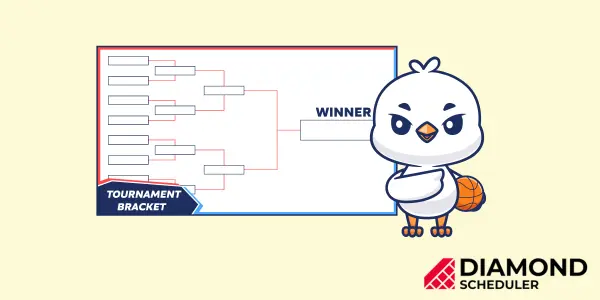
7-Team Double Elimination Enhanced with Software
Have you ever wondered what lies behind the excitement of sports leagues like the NCAA or the World Series? Even tournaments that are considered "boring" sports, like chess, seem to be filled with thrilling moments.
There are second chances, legendary comebacks, and unforgettable stories of the underdog going home as champions. Well, the secret lies in the use of the double-elimination bracket format for scheduling.
The magic is in scheduling competitive, nail-biting, but fair match-ups and using scheduling software such as the one provided by Diamond Scheduler.
By using scheduling software, leagues can manage their tournaments, coordinate the opponents, avoid conflicts with scheduling, and put together a fair and competitive playoff run for the championship title.
Diamond Schedulers software is league management for the pros. Not only is the interface user-friendly and easy to use, but it has customization capabilities that truly allow league managers to tailor the schedule to their specific needs.
Building your tournament brackets with Diamond Scheduler will be a game-changer for your league and staff productivity.
In this article, we will examine how to use the double-elimination format even if you only have 7 teams. We'll also take a look at exactly how to use a winner's and loser's bracket when you have an uneven number of competitors.

How does the 7-team double-elimination bracket work?
Let's look at exactly how the double-elimination bracket works when you have 7 teams. Seven opponents in a tournament are unique in the sense that there is an uneven number of teams. This means that it will be slightly different from the standard tournament or double-elimination format.
Of course, we know that the double elimination brackets format includes a winners bracket and a losers bracket. This means that competitors have a second chance. Should a team lose a match, they will not automatically be eliminated and sent packing, as they would be in a single elimination brackets tournament.
These teams are given a second chance at victory by being moved down into the lower bracket. This makes it the perfect opportunity for the Cinderella story of an underdog team that goes home with the trophy.
The inherent challenge of organizing a bracket with seven teams lies in the fact that there are an uneven number of opponents. League organizers need to approach this challenge strategically and be careful in deciding which teams will receive a bye.
How to find the number of games needed for a single elimination bracketExploring the term ‘Bye’ in sports tournaments
What is a bye? A bye is when one team doesn't face anyone in a match-up and moves on to the second round of matches automatically. This ensures that an even amount of opponents are moving through to the second round and that the tournament schedule is balanced.
League managers need to be careful when choosing the team that receives a bye, as there are various criteria that they need to consider. Organizers can look at things such as where a team is seeded, how they performed in previous competitions, or even using a random selection process.
Whatever method the organizers choose, they need to do so strategically, as this can impact the path of the tournament and could hold potential advantages for teams in later rounds.
The advantages and disadvantages of receiving a 'Bye'
There are some benefits for teams that receive a Bye. Not only does it mean that the team has some extra time for preparation and rest, but they also get to watch their opponents play and may be able to develop strategies to defeat them.
On the flip side, though, is the fact that the competitors who are given a bye may lose momentum since they won't be playing in every round, and their free time means that they lose or decrease in mental and physical game readiness.
Despite the disadvantages, the 7-team bracket promises a thrilling tournament and championship game. Because there are only a small amount of opponents, every match-up matters, and with each new round, the pressure to win is intensified.
It leads to a highly competitive environment for the players and the audience. There are also many other advantages to a 7 team double elimination format. Using a Bye within the 7-team double elimination bracket allows for a balanced schedule.
This is because each team will compete against a similar number of opponents. This balanced scheduling means that there is a sense of fairness in the tournament and that the schedule won't have too much of an impact on the outcome of the tournament.
Selecting scheduling software: get on team Diamond Scheduler
With the correct scheduling software, you can take your league or team management from chaotic to coordinated. It's understandably difficult to schedule for a 7-team bracket, and doing so manually could lead to errors, conflicts, or confusion.
By using scheduling software, the human element is removed, and with it, the chance of making mistakes and the opportunity to save time.
Using software to schedule league championship series also means that league managers are free to focus on other aspects of the tournament rather than having to spend precious time researching venue availability, team preferences, or team constraints.
The automated nature of the software will also take care of collecting and sorting data. League managers can now access statistics and trends, which can help them make better decisions for future tournaments.
Here are the factors organizers need to consider when choosing their scheduling software:
1. User-friendly interface:
League managers need to be able to navigate their way through the software with ease. The purpose of using scheduling software within league operations is to make the creation of matchups easier.
Therefore, the software needs to have clear menus and a simple step-by-step process of removing or adding information in order to create a solid schedule.
2. Customization capabilities:
As we've discussed, the 7-team double elimination format can be tricky to schedule due to the uneven number of opponents. Therefore the scheduling software that a league organizer chooses needs customization options to accommodate this.
3. Integration and compatibility:
League managers don't use software exclusively for scheduling purposes; other aspects of the tournament also utilize automated systems.
Things such as registration, communication, and scorekeeping are automated in order to increase the efficiency of league operations.
It is, therefore, crucial that the scheduling software chosen can integrate with other programs, such as Diamond Scheduler's software integration with SportsEngine.
Seamless data sharing will reduce the amount of duplicate data entry, will make scheduling more efficient, and will reduce or remove other tasks, such as manual registration processes.
Finding software that offers all these unique features may have been difficult to find in the past, but not anymore. Diamond Scheduler's unique scheduling software makes tournament scheduling a breeze.
Breaking down college baseball bracketKey details needed to set up a tournament using Diamond Scheduler
Setting up a double-elimination bracket using the Diamond Scheduler scheduling software is as easy as one, two, or three. Below are the key details league owners should have when creating a tournament in Diamond Scheduler.
Tournament details: The intricate details hold the key
The foundation of a good schedule starts with the details. Luckily the automated software will sweat the small stuff, and the league organizer just needs to focus on inputting the information correctly.
League managers need to ensure that they input the correct start and end dates, accurate venue locations, and of course, the competition's name.
Define the structure of the tournament
Next, the scheduler will ask organizers to define the structure of the competition, whether it be single or double-elimination or round-robin.
Organizers can choose the number of rounds, matches per round, and any other parameters needed. Diamond Scheduler software is very flexible and accommodates various formats.
Mastering organization: adding opponent details to the platform
Now organizers are ready to input participant information, and Diamond Scheduler makes this process effortless. The software has bulk import options which means that organizers can add multiple opponents at the same time. Team names, sports logos, and contact details can be added without trouble.
When, where, and at what time?
When a league manager is scheduling their championship or playoff tournament, many elements regarding the venues, times of matches, and days of play need to be considered. Such things as the team preferences, the travel distances, and certain logistical constraints must be kept in mind.
There are also issues with how much rest one team gets over another.Then organizers have to think about external factors such as the weather. With all of these factors to consider, it may be difficult to create a professional-looking schedule that is easy to read.
With Diamond Schedulers software, this is possible, and league owners can easily reschedule games due to weather, previous commitments of participants, or conflicting schedules.
Frequently asked questions
Can I edit and customize the 7-team double elimination bracket on Diamond Schuduler's site?
Yes. The platform allows you to edit and customize the bracket. You can modify team names, seedings, game durations, and other settings to fit your tournament requirements.
Is it possible to save and fill in the game results as the tournament progresses?
Yes, the website provides the option to save the bracket and fill in the game results as each match is played. This ensures that you can track the progress of the tournament and have a record of all the games and their outcomes.
Do I need to be a loser to continue playing in a double-elimination tournament?
No, the double-elimination format allows all participants to continue playing regardless of whether they have lost a game or not. Even if a team loses a game, they move to the loser's bracket and still have one more chance to compete for the championship.
This format ensures that competitors have two opportunities to stay in the tournament and potentially win the title.
To recap
A 7-team double-elimination bracket was something that team organizers were wary of taking on due to the difficulties of accommodating the uneven number of participants while still keeping the competition fair and equal.
Now this process can be seamless. Organizers can elevate their game by using Diamond Schedulers tools for the creation of a simplified, organized, and efficient game schedule.
👉 Couldn't find what you needed? Get our 7-team single-elimination printable, 7-team double-elimination printable, or our 7-team round-robin printable for your upcoming tournament!
Thalia Oosthuizen has been writing in a professional capacity for over a decade. Her love for sports has led her down the path of sports writing, where her passion and skills combine. Thalia is a runner, cyclist, and swimmer, and enjoys playing tennis and hockey. Her favorite sports teams include Chelsea F.C. and the Georgian Lions Rugby Club.
About Diamond Scheduler
Diamond Scheduler makes planning your league’s complex season easier than ever. Create your first schedule in minutes for free. It's fast, fun, and simple.



